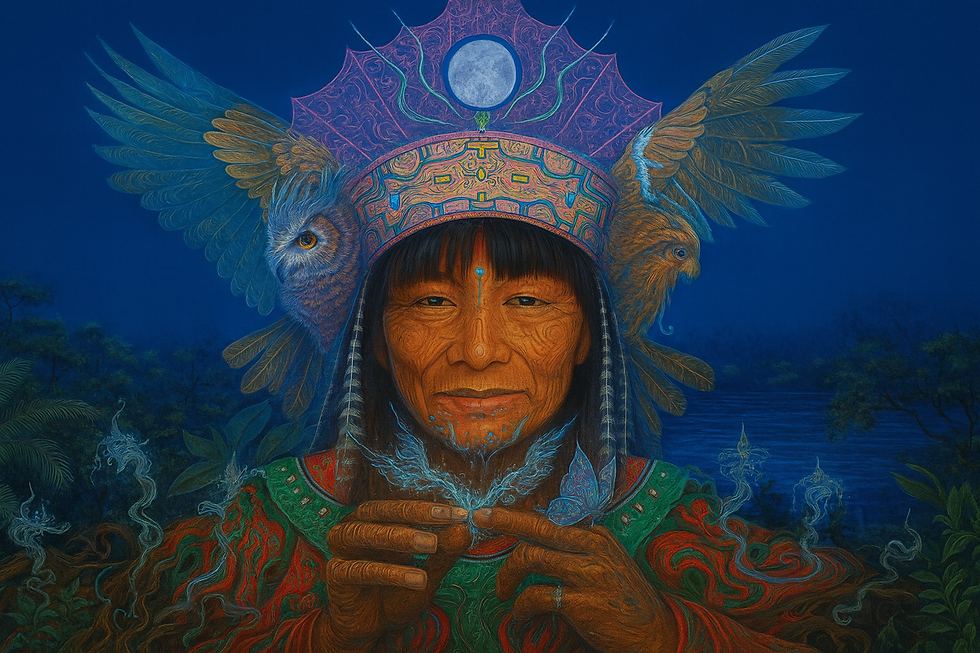What Is Ayahuasca? Experience, Benefits, and Side Effects
- TaitaInti
- 22 hours ago
- 3 min read

In the heart of the Amazon jungle, a sacred brew has been used for generations to open minds, cleanse bodies, and reconnect humans with the spirit of nature. This potent plant medicine, known as Ayahuasca, is now at the center of a global healing movement — and a growing scientific interest.
But what exactly is Ayahuasca? What can you expect from the experience, and how do its benefits compare to its risks?
Let’s explore.
Ayahuasca Ceremony and Experience
An Ayahuasca journey is unlike anything else. It usually begins at night, in a space that has been carefully prepared and spiritually cleansed by a shaman or facilitator. Participants are invited to drink the brew, made from Banisteriopsis caapi vine and Psychotria viridis leaves.
Within 30 to 60 minutes, the effects begin — sometimes with nausea, dizziness, or emotional waves. Visions may follow: of light, geometry, personal memories, or even ancestral guidance.
The ceremony often includes icaros (healing songs), silence, and support from the shamanic team. For many, the experience is emotionally intense — sometimes beautiful, sometimes terrifying, always unforgettable.
Some ceremonies are repeated over several nights, allowing a deeper unfolding of insight.
How Is Ayahuasca Used?
Outside of the Amazon, Ayahuasca is used primarily in retreat settings, where participants prepare through specific diets and restrictions: avoiding alcohol, caffeine, sex, certain medications, and often animal products for days or weeks beforehand.
Why? Because the brew doesn’t just affect the mind — it cleanses the body. And entering the experience with a cleaner system often leads to a more manageable journey.
Ayahuasca is never casually consumed. It is always approached as a sacred ritual — and in traditional settings, the shaman is responsible not just for preparation and safety, but for energetically guiding the group.
Potential Benefits of Ayahuasca
Thousands of people report that Ayahuasca helped them make life-changing breakthroughs — and science is beginning to take note.
May Benefit Brain Health
Lab research shows that DMT can stimulate receptors involved in neuroprotection, while harmine, a key compound in the brew, encourages the growth of new brain cells. This suggests Ayahuasca may support mental clarity, memory, and long-term brain function.
May Improve Psychological Well-Being
In carefully monitored settings, Ayahuasca has been linked to increased emotional resilience, mindfulness, and reduced stress. Some studies compare its effects to those of extended meditation programs.
May Help with Certain Mental Health Conditions
Early trials and case studies suggest that Ayahuasca may be especially helpful for people struggling with depression, anxiety, PTSD, and even substance use disorders. These improvements often occur after just one or two sessions — though proper integration is key.
Effects
Ayahuasca impacts each person differently. Some report profound joy, connection, and peace. Others experience fear, grief, or discomfort as long-buried memories or traumas surface.
Common physical and psychological effects include:
Visual or auditory hallucinations
Deep emotional release or catharsis
A sense of interconnectedness
Temporary nausea, vomiting, or diarrhea (often seen as purification)
Introspection, spiritual insight, or ego dissolution
The intensity and nature of the effects depend on your mindset, physical state, dosage, and the environment in which it is taken.
Considerations and Potential Side Effects
Despite its growing popularity, Ayahuasca is not safe for everyone. Its effects on the body and mind can be destabilizing if approached unprepared or without proper support.
Interactions
Ayahuasca can react dangerously with many medications, especially antidepressants, stimulants, Parkinson’s drugs, and even over-the-counter cold or diet pills. These interactions can be fatal. Full disclosure of your medical history is essential before attending a ceremony.
Worsening Symptoms
Those with schizophrenia, bipolar disorder, or psychosis are advised to avoid Ayahuasca, as it may exacerbate underlying mental conditions.
Cardiac Issues
The brew can raise blood pressure and heart rate, posing a serious risk to individuals with heart conditions or hypertension.
Lack of Oversight
While some retreat centers operate with high integrity, others do not. Untrained or exploitative shamans exist, and lack of medical staff in remote locations can be dangerous. Participants are advised to research facilitators thoroughly and choose established, ethical retreat centers.
Access to Medical Care
Ceremonies often take place in jungles or rural areas — far from emergency medical facilities. Those with medical concerns should weigh this seriously when planning their journey.
Takeaway
Ayahuasca is not a miracle drug. But it can be a powerful tool for transformation when used responsibly, in the right setting, and with proper preparation. For some, it brings emotional healing, clarity, and purpose. For others, it reveals unresolved inner wounds that require time and integration.
Ultimately, the experience is as much about surrender as it is about insight.


Comments